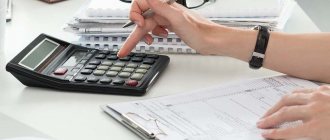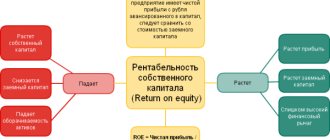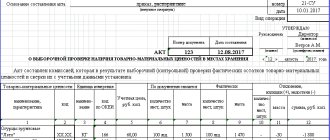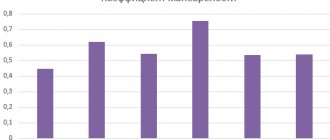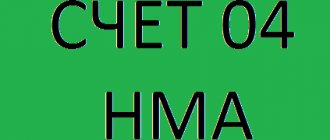Accounting
The disposal of fixed assets is regulated by section 5 of PBU 6/01 (clauses 29-31). Proceeds from the sale of fixed assets are taken into account in the amount agreed upon by the parties to the agreement, and income or expenses received from the sale are recorded in the reporting period when the transaction was completed. In accounting, to reflect the result from the sale of fixed assets, account 91 “Other income and expenses” is used, since fixed assets do not belong to the category of goods/products and income from their sale cannot be considered income from core activities. Accordingly, the costs incurred by the enterprise when selling OS are classified as other expenses.
Income from the sale of fixed assets is recorded on the credit of account 91, and VAT, the residual value of the asset and the costs associated with its sale are recorded on the debit side. In addition to reflecting income and expenses from the sale of fixed assets, accounting reflects the write-off of depreciation accrued at the time of disposal of the property.
How to determine the cost of fixed assets (fixed assets)?
Determining the initial cost of a fixed asset is necessary in order to correctly accept it for accounting. Essentially, these are the company's costs for acquiring this property.
What is included in the initial costs?
- Money paid to the OS supplier under the purchase and sale agreement;
- Costs for delivery of the OS to the site and installation (if necessary);
- Construction costs (if necessary);
- Payment for the work of an intermediary when purchasing property;
- Customs and government duties and fees;
If the asset was received as a gift, then the value is determined according to the average market price on the day when the asset was accepted for accounting.
It is important to remember: companies on OSNO do not include VAT in the initial cost of fixed assets.
Sales of fixed assets: transactions
As a rule, to account for the disposal of an object, the accountant opens a special sub-account (for example, 01/2), to which he transfers the initial or restored cost of the property being sold, and then writes off the accumulated depreciation listed in the account. 02. The main transactions accompanying the sale of fixed assets are as follows:
| Operation | D/t | K/t | Documenting |
| Based on the signed purchase and sale agreement, the buyer’s debt for the asset being sold is taken into account | 62 | 91/1 | Contract of sale |
| The original cost of the object has been written off | 01/2 | 01/1 | Write-off report No. OS-4, OS-4a, OS-4b |
| The accumulated depreciation on the object is written off | 02 | 01/2 | Accounting certificates |
| The residual value of the fixed assets is taken into account (if any) | 91/2 | 01/2 | |
| The amount of the additional valuation was written off (if it was made) | 83 | 84 | |
| Costs associated with the implementation of the OS have been written off | 91/2 | 20,26,44, 60,76 | Service agreements, acts, accounting certificates |
| VAT on the cost of the sold asset | 91/2 | 68 | Invoice |
| Receipt of funds from the buyer | 51 | 62 | Bank statement |
Let's figure out how the sale of a fixed asset is reflected in the accounting of the selling company, and what entries should be made.
Example: selling an asset with residual value
A company operating at OSNO sells the machine under a sales contract. The cost of the object specified in the agreement is RUB 312,000, incl. VAT 20% - 52,000 rub. The initial price of the machine is 350,000 rubles; during the operation of the facility, depreciation in the amount of 128,000 rubles has been accrued. There was no additional assessment of the value of the property.
Pre-sale preparation was carried out - the worn-out unit was replaced using the company’s own resources. The cost of repairs is 12,000 rubles. excluding VAT (applies to costs associated with the sale). A third-party company dismantled the machine under a contract. The cost of her services was 10,000 rubles. without VAT. The delivery of the object under the contract was carried out by the seller, paying a specialized transport company 6,000 rubles, incl. VAT – 1000 rub.
In accounting, the listed transactions will be reflected as follows:
| Operation | Postings | Amount (rub.) | |
| D/t | K/t | ||
| Income recorded: fixed asset sold | 62 | 91/1 | 312 000 |
| Payment has been received to the bank account | 51 | 62 | 312 000 |
| VAT charged | 91/3 | 68 | 52 000 |
| Tax paid | 68 | 51 | 52 000 |
| Decommissioned: | |||
| — initial price of the machine | 01/2 | 01/1 | 350 000 |
| - wear and tear at the time of sale | 02 | 01/2 | 128 000 |
| — residual value of the machine (350000 – 128000) | 91/2 | 01/2 | 222 000 |
| Costs taken into account: | |||
| - for repairs | 91/2 | 20 | 12 000 |
| - for dismantling | 91/2 | 76 | 10 000 |
| - upon delivery | 91/2 | 76 | 5000 |
| VAT is charged on delivery services | 19 | 76 | 1000 |
| VAT is accepted for deduction | 68 | 19 | 1000 |
| The result is reflected - profit from the sale of the machine (312000 – 52000 – 222000 – 12000 – 10000 – 5000) | 91 | 99 | 11 000 |
In the presented example, the sale of the OS was made upon the transfer of the object by transferring money to the account. If the contract provides for prepayment (in full or partial), then the seller must charge VAT on the advance amount and then claim its reimbursement. The wiring will be slightly different.
Example: sale of OS on condition of full prepayment
In the conditions of the previous example, let’s allow a change - the buyer transferred an advance in the amount of 312,000 rubles. in April 2020, and the machine was delivered in May. For the sale of fixed assets, the postings in this situation will be as follows:
| Period | Operation | D/t | K/t | Amount (rub.) |
| April | Advance received | 51 | 62/AB | 312 000 |
| VAT on advance | 76/AB | 68 | 52 000 | |
| May | Sales income | 62 | 91/1 | 312 000 |
| VAT upon delivery of OS | 91/3 | 68 | 52 000 | |
| VAT refund on advance payment | 68 | 76/AB | 52 000 | |
| Decommissioned: | ||||
| - initial cost | 01/2 | 01/1 | 350 000 | |
| - accumulated wear | 02 | 01/2 | 128 000 | |
| — residual value | 91/2 | 01/2 | 222 000 | |
| - costs associated with the sale | 91/2 | 20 | 12 000 | |
| - for dismantling | 91/2 | 76 | 10 000 | |
| - upon delivery | 91/2 | 76 | 5000 | |
| VAT on delivery | 19 | 76 | 1000 | |
| Accepted for deduction of VAT on delivery | 68 | 19 | 1000 | |
| Advance credited towards payment | 62/AB | 62 | 312 000 |
Step-by-step instruction
Attention! The VAT rate has been changed from 01/01/2019 from 18% to 20% and from 18/118 to 20/120.
On June 29, the Organization sold a Ford Mondeo car to the buyer Tekhnologiya LLC at a price of RUB 401,200. (including VAT 18%). On the same day, the Ford Mondeo was deregistered with the traffic police.
Depreciation in accounting and for profit tax purposes was calculated using the straight-line method. The depreciation bonus for sold fixed assets was applied in the amount of 30%.
The residual value of the fixed asset (BU = 647,856 rubles, NU = 453,499.20 rubles) exceeded sales revenue.
The parties to the transaction are not interdependent persons.
Sales are made before the expiration of 5 years from the date of commissioning of the vehicle.
Its remaining useful life is 48 months.
On July 2, payment was received from the buyer to the bank account in the amount of RUB 401,200.
Let's look at step-by-step instructions for creating an example. PDF
| date | Debit | Credit | Accounting amount | Amount NU | the name of the operation | Documents (reports) in 1C | |
| Dt | CT | ||||||
| OS implementation | |||||||
| June 29 | 62.01 | 91.01 | 401 200 | 401 200 | 340 000 | Revenue from OS sales | OS transfer |
| 26 | 02.01 | 13 497 | 9 447,90 | 9 447,90 | Calculation of depreciation for the last month | ||
| 02.01 | 01.09 | 26 994 | 18 895,80 | 18 895,80 | Write-off of accumulated depreciation | ||
| 01.09 | 01.01 | 674 850 | 472 395 | 472 395 | Write-off of the initial cost of the OS | ||
| 91.02 | 01.09 | 647 856 | 453 499,20 | 453 499,20 | Write-off of residual value of fixed assets | ||
| 91.02 | 68.02 | 61 200 | VAT accrual on revenue | ||||
| Issuance of SF for shipment to the buyer | |||||||
| June 29 | — | — | 401 200 | Issuing SF for shipment | Invoice issued for sales | ||
| — | — | 61 200 | Reflection of VAT in the Sales Book | Sales book report | |||
| Deregistration of a car | |||||||
| June 29 | — | — | — | Removing a car from registration with the traffic police | Register of information Registration of vehicles - Deregistration | ||
| Reflection in the tax accounting amount of the loss from the sale of fixed assets | |||||||
| June 29 | 97.21 | 99.01.1 | — | 113 499,20 | 113 499,20 | Transfer of the amount of loss from the sale of fixed assets to the remaining private investment fund (NU) | Manual entry - Operation |
| Receipt of payment from the buyer | |||||||
| July 02 | 51 | 62.01 | 401 200 | 401 200 | Receipt of payment from the buyer | Receipt to the bank account - Payment from the buyer | |
| Accounting for the monthly amount of loss as part of indirect expenses for NU | |||||||
| July 31 | 91.02 | 97.21 | — | 2 364,57 | 2 364,57 | Accounting for the monthly amount of loss as part of indirect expenses (IO) | Closing the month - Write-off of deferred expenses |
For the beginning of the example, see the publications:
- Purchasing a car
- Acceptance for accounting of fixed assets with bonus depreciation
Deregistration of a car
Deregistration of a vehicle with the State Traffic Safety Inspectorate is completed in the register of information Registration of vehicles, type of operation Deregistration in the section Directories - Taxes - Transport tax.
The register indicates:
- Fixed asset - a vehicle that is deregistered;
- Date - the date of its deregistration with the traffic police.
Issuance of SF for shipment to the buyer
You can issue an invoice to the buyer by clicking the Issue an invoice on the document Transfer of fixed assets .
Invoice data is automatically filled in based on the document Transfer of Assets .
- Operation type code : “Sale of goods, works and services and operations equivalent to it.”
Documenting
You can print the completed invoice form by clicking the Print document Invoice issued document or the document Transfer of fixed assets .
Sales Book report can be generated from the Reports – VAT – Sales Book section.
VAT declaration
The amount of accrued VAT is reflected in the VAT return:
In Section 3 p. 010 “Implementation (transfer on the territory of the Russian Federation...)”:
- amount of sales revenue, excluding VAT;
- the amount of accrued VAT;
In Section 9 “Information from the sales book”:
- invoice issued. Operation type code "".
How to register a fixed asset?
The initial cost of fixed assets is accumulated in account 08 “Investments in non-current assets”. After preliminary work (installation, construction), the fixed asset is officially put into operation.
Entry: D01 - K08 - for the amount of the initial cost of the object.
Be sure to include in the accounting asset the act of acceptance and transfer of fixed assets. It is drawn up in any form, or in a unified No. OS-1.
When registering, it is important to select the useful life of the asset according to classifier No. 1, approved by the Decree of the Government of the Republic of Kazakhstan on January 1, 2002.
Accounting for profit or loss from the sale of fixed assets
Co = Sp - Am - Amp, where
- Co - the residual value of the object for calculating income tax;
- SP - the initial cost of the property;
- Am - accumulated depreciation on fixed assets;
- Amp is the depreciation bonus that was accrued on the fixed asset.
If a company calculates depreciation not by linear, but by other methods, then the residual value should be calculated in accordance with paragraph 1 of Article 257 of the Tax Code of the Russian Federation.
The amount of depreciation bonus on fixed assets consists of additional expenses incurred for the acquisition of property, as well as the amount of financial investments aimed at modernizing or completing the facility. The amount of depreciation bonus is usually reflected in accounting as a debit to account 08 and is simultaneously accepted as an expense when calculating income tax for tax purposes. Moreover, in an amount of no more than 10-30 percent of the original price of the property.
However, if the fixed asset has been in use for less than 5 years, and the sale is carried out by an interdependent organization, then the amount of the depreciation bonus is subject to restoration and inclusion in income under the non-refundable income. Such instructions are presented in the letter of the Ministry of Finance of Russia dated December 23, 2014 No. 03-03-06/1/66590.
https://www.youtube.com/watch?v=upload
We suggest you read: Establish paternity without DNA examination
The sale of an organization's property is recognized in tax accounting as an ordinary sale and is therefore subject to VAT at the rate of 18%.
However, there are exceptions. If the property was used in an activity that does not fall under OSNO, and when purchasing the object, input VAT was not deducted, then when selling the fixed assets, calculate value added tax at the rate of 18/118. Moreover, an interest rate of 18/118 must be applied to the discrepancy between the price and the residual value of the fixed asset.
Such instructions are presented in the letter of the Ministry of Finance of Russia dated March 26, 2012 No. 03-07-05/08.
Let's look at the accounting entries for this operation using a specific example.
NPO Dobrovol decided to sell the machine. The selling price of the machine is 118,000.00 rubles. Including VAT - 18,000.00 rubles. The initial cost of the machine is RUB 130,000.00.
Depreciation has been accumulated on fixed assets in the amount of RUB 75,000.00.
| Operation | Debit | Credit | Sum |
| The initial cost of an asset, written off | 01/1 | 01 | 130 000,00 |
| Depreciation accumulated on fixed assets is written off | 02 | 01/1 | 75 000,00 |
| The residual value of the object has been written off (original minus depreciation) | 91/2 | 01/1 | 55 000,00 |
| Accrued proceeds from the sale of property | 62 | 91/1 | 118 000,00 |
| VAT charged | 91/2 | 68 | 18 000,00 |
| The funds were transferred to the NPO's bank account | 51 | 62 | 118 000,00 |
For a long time, the profit from the sale of fixed assets was considered to be the difference between the NSR and the residual book value, to which was added the inflation index (IRI), published by the State Statistics Committee of the Russian Federation. However, since this index is not applied to profits from the sale of assets, Goskomstat no longer publishes it.
For tax purposes, profit from the sale of fixed assets represents capital expenditure, from which the following are sequentially subtracted: the residual book value of the fixed asset and sales costs.
Sometimes it happens that the implementation of an OS is carried out to the detriment of the company.
A loss from the sale of fixed assets is recognized if the residual value, together with sales costs, exceeds the NSR, that is, the revenue received.
Such a loss cannot be taken into account on the balance sheet immediately after sale, so that its amount reduces the income tax base. The lost funds will have to be distributed in equal parts over the months that remain from the moment of the transaction until the end of the useful life of the sold OS. This is reflected in the tax register “Accounting for deferred expenses”.
Documentation of the acquisition of fixed assets
As a rule, the acquisition of fixed assets is formalized by a purchase and sale agreement (clause 2 of article 219, clause 1 of article 424 of the Civil Code of the Republic of Belarus, hereinafter referred to as the Civil Code). It should reflect the value of the property, the procedure for its sale and acquisition, and the procedure for payment.
Important! When purchasing real estate or vehicles, it is necessary to register the transaction with the relevant authorities (BRTI, traffic police).
When selling fixed assets, a legal entity is required to prepare primary accounting documents confirming the fact of the transfer. Such documents will be TTN-1 or TN-2 (clause 2 of the Instructions for filling out standard forms of primary accounting documents TTN-1 “Consignment note” and TN-2 “Consignment note”, approved by Resolution of the Ministry of Finance of the Republic of Belarus dated December 18, 2008 No. 192), the act of acceptance and transfer of fixed assets, established by Resolution of the Ministry of Finance of the Republic of Belarus dated April 22, 2011 No. 23.
If fixed assets are purchased from an individual, then the basis for accepting them for accounting in the organization will be the act of acceptance and transfer of fixed assets, drawn up in any form, taking into account the requirements for the preparation of primary documents (subclause 1.4 clause 1 of the Decree of the President of the Republic of Belarus dated 15.03 .2011 No. 114 “On some issues of using primary accounting documents”). Such an act must indicate: the date and place of its preparation, the cost of fixed assets, their quantity. When transferring a used fixed asset, it is advisable to indicate its characteristics and condition.
Below, using examples, we will look at how to fill out the forms of primary documents that should be drawn up when selling fixed assets from one legal entity to another.
Situation
LLC "Center" sells to UE "Samik" used fixed assets - a computer and a printer.
Let us consider the main points of documentary and accounting registration of such operations.
This transaction must be formalized by a purchase and sale agreement. In this agreement, incl. It is necessary to indicate the value of the property being sold. It should be taken into account that the selling price can be either higher than the residual value or lower, i.e. is negotiable. In this case, the selling price is higher than the residual price.
Important! The specification and delivery note should indicate the selling prices that are agreed upon between the seller and the buyer.
The specification for the contract can be drawn up as follows:
If the seller is a legal entity and the property being sold is taken into account as a fixed asset, then when drawing up an act of acceptance and transfer of fixed assets, the following must be taken into account.
In this act, the transferring party fills out section in both copies. 1 “Information on the condition of the fixed asset as of the date of transfer,” which indicates the date of issue (creation) or acquisition of the fixed asset, the date of its commissioning, the actual period of use, the original cost and the amount of accrued depreciation. This information must be taken into account by the commission for implementing the buyer’s depreciation policy when making a decision on establishing the service life of this fixed asset, as well as when conducting revaluation in accordance with the law.
The buyer fills out only section in his copy. 2 and 3. In Sect. 2 “Information on the condition of the fixed asset item as of the date of acceptance for accounting”, the buyer indicates the initial cost upon acquisition.
Important! The initial cost consists of the actual costs of acquisition, delivery, installation, installation, therefore the cost of the fixed asset in Sect. 1 and 2 may differ.
If the purchased fixed assets require installation, the buyer fills out section. 2 and 3 only after installation.
For reference: if property is purchased from an individual or from a legal entity on whose balance sheet it was not listed as a fixed asset, then only the buyer enters information into the transfer and acceptance certificate of fixed assets. At the same time, Sect. 1 is not filled in.
The act may look like this:
Use of fixed assets: features of depreciation calculation
When putting a fixed asset into operation, the commission for implementing depreciation policy (hereinafter referred to as the commission) must approve the standard service life of the fixed asset, its useful life, as well as the depreciation rate.
When purchasing used fixed assets, you need to take into account the following: the standard service life can be set 2 times lower than provided by law, but not less than 3 years for buildings, structures and transmission devices and 2 years for other fixed assets ( clause 18 of Instruction No. 37/18/6*). __________________________ * Instructions on the procedure for calculating depreciation of fixed assets and intangible assets, approved by Resolution of the Ministry of Economy, the Ministry of Finance and the Ministry of Construction and Architecture of the Republic of Belarus dated February 27, 2009 No. 37/18/6 (hereinafter referred to as Instruction No. 37/18/6).
In the above situation, an organization purchases a used computer and printer. The computer and printer have a standard service life of 5 years (codes 48009 and 48003, respectively), so the commission has the right to set a standard service life of 5 years, 2.5 years and 2 years.
If the period of actual use of the object on the date of acquisition turns out to be equal to or more than the corresponding value given in the classification of depreciable fixed assets, then the commission has the right to determine the standard service life for it independently, taking into account the technical condition. In this case, the service life must be at least 1 year.
For reference: if a fixed asset was purchased from an individual and there is no data on the period of use of the property, then it is permissible to determine the service life according to the data specified in the technical documentation of the manufacturer. If there are no such documents, then the standard service life of the fixed asset can be established by assessing its technical condition by the commission.
After establishing the standard service life, it is necessary to determine the useful life, which may be equal to or different from the standard service life. In this case, it is necessary to take into account the norms of Appendix 3 to Instruction No. 37/18/6, in which fixed assets are divided into 8 groups. Each of them has a useful life range. The lower and upper limits of the range are calculated by multiplying the standard service life by the coefficient given in the table. The period is set in years (months) and cannot be less than 1 year.
Accounting The initial data for the computer being sold is shown in the following table:


